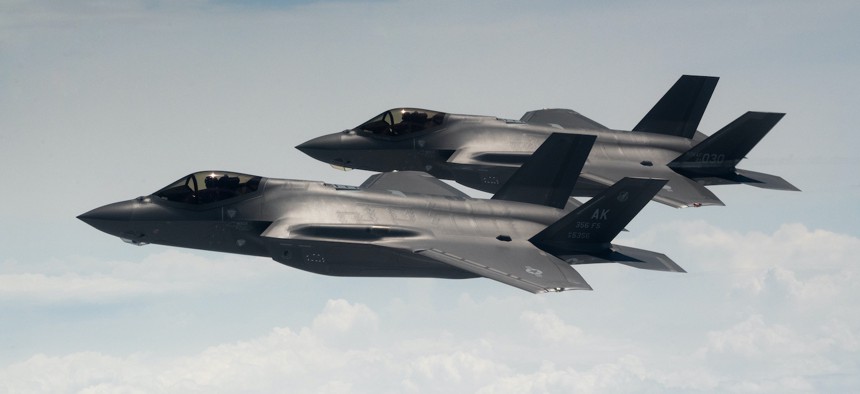
U.S. Air Force F-35 Lightning IIs from the 356th Fighter Squadron at Eielson Air Force Base, Alaska, fly side by side with Republic of Korea Air Force F-35s from the 151st and 152nd Combat Flight Squadrons as part of a bilateral exercise over the Yellow Sea, Republic of Korea, July 12, 2022. U.S. Air Force / Senior Airman Trevor Gordnier
Pentagon Could Block 80-Plus Deliveries of F-35s
The Pentagon has stopped accepting newly built stealth fighters from Lockheed until tech trials are finished.
More than 80 F-35s could be left in limbo as the Pentagon refuses to accept new jets until testing of updated technology on the stealth fighters is complete.
Deliveries of new F-35s are on hold until December at the earliest and April at the latest, according to F-35 Joint Program Office spokesperson Russ Goemaere.
That means Lockheed Martin will have to sit on 45 jets if the delay extends to December and 81 jets if it extends to April, as the company’s contract stipulates it must deliver nine planes per month with the tech upgrade.
The Pentagon is updating several technologies in its fleet of F-35s, an effort known as Block 4. But before the fleet can receive the upgrades, the jets need a suite of hardware and software improvements, known as Technology Refresh 3, or TR-3, which is already one year behind schedule.
“Starting in August, approximately nine TR-3 aircraft per month are contracted for delivery,” Goemaere told Defense One in a statement. “Starting later this summer, F-35 aircraft coming off the production line with TR-3 hardware will not be accepted (DD250) until relevant combat capability is validated in accordance with our users’ expectations. The JPO and Lockheed Martin will ensure these aircraft are safely and securely stored until DD250 occurs,” Goemaere said.
Breaking Defense first reported that the Pentagon will not accept new F-35s until testing concludes.
While the JPO estimates the delay could last until next spring, Lockheed said they still plan to deliver by December.
“In all test programs there are risk analysis models. While the JPO recognizes there could be a delivery range between Dec. 2023 and April 2024, we remain committed to delivering the first TR-3 jet in 2023,” the company said in a statement.
Asked if there would be financial ramifications for the company due to the delay, Lockheed said they could not comment due to being in the quiet period before it reports second quarter earnings next month.
In the near term, the slip in TR-3 deliveries means less capacity for the Air Force, Doug Birkey, executive director of the Mitchell Institute for Aerospace Studies, told reporters Wednesday, ahead of the release of a new report on 5th-generation airpower.
Air Combat Command is “literally managing tail by tail right now” to avoid a gap in capacity, Birkey said.
“That said, Lockheed Martin is still producing jets, and they're stacking up out in Fort Worth, [Texas]. That is capacity that will be reintroduced rapidly once you've crossed the threshold, because software is in play. This is an easy upload relatively speaking…so I think it will be rapidly recoverable,” he said. “Our position I think really is: produce these things as fast as you possibly can, allocate the cash, keep it moving, [and] this too shall get sorted out and move on.”
The first TR-3 flight test flew in January—an “important milestone” but one that uncovered software problems that “the contractor did not identify in software labs,” according to a recent Government Accountability Office report. New issues mean the program faces a tighter timeline to complete additional tests and fix software problems.
The cost of Block 4 upgrades continues to climb, with an increase of $1.4 billion since GAO’s April 2022 report, bringing the total cost to $16.5 billion, according to GAO.
But Birkey said not just the industrial base is to blame for F-35 delays and cost increases.
“If you do the forensics on that—it’s everybody: you look at the appropriators dinging this for years, certainly the industrial base has huge issues on it as well, the services took risk on it, the structure of the JPO [has] got problems, things endemic to the design of a program,” he said.
Despite that, Block 4 is the only lever the Pentagon has to get this program healthy, Birkey said. Combatant commands need solutions—and this is a good solution, he said.
“I think TR-3/ Block 4 will be fundamentally, radically better. In many ways, it's an entirely new jet,” Birkey said.
TR-3 is the “IT backbone” of Block 4 upgrades, and will feature a new integrated core processor needed for sensors and weapons in the future, Greg Ulmer, executive vice president of Lockheed’s Aeronautics business, told Defense One last week at the Paris Air Show.
Ulmer said they’re conducting flight testing for the new configuration at Edwards Air Force Base and Naval Air Station Patuxent River right now, “so you'll see us complete that flight test, we'll get the certifications underwritten, certified by the government, and then you'll see us resume delivery.”




